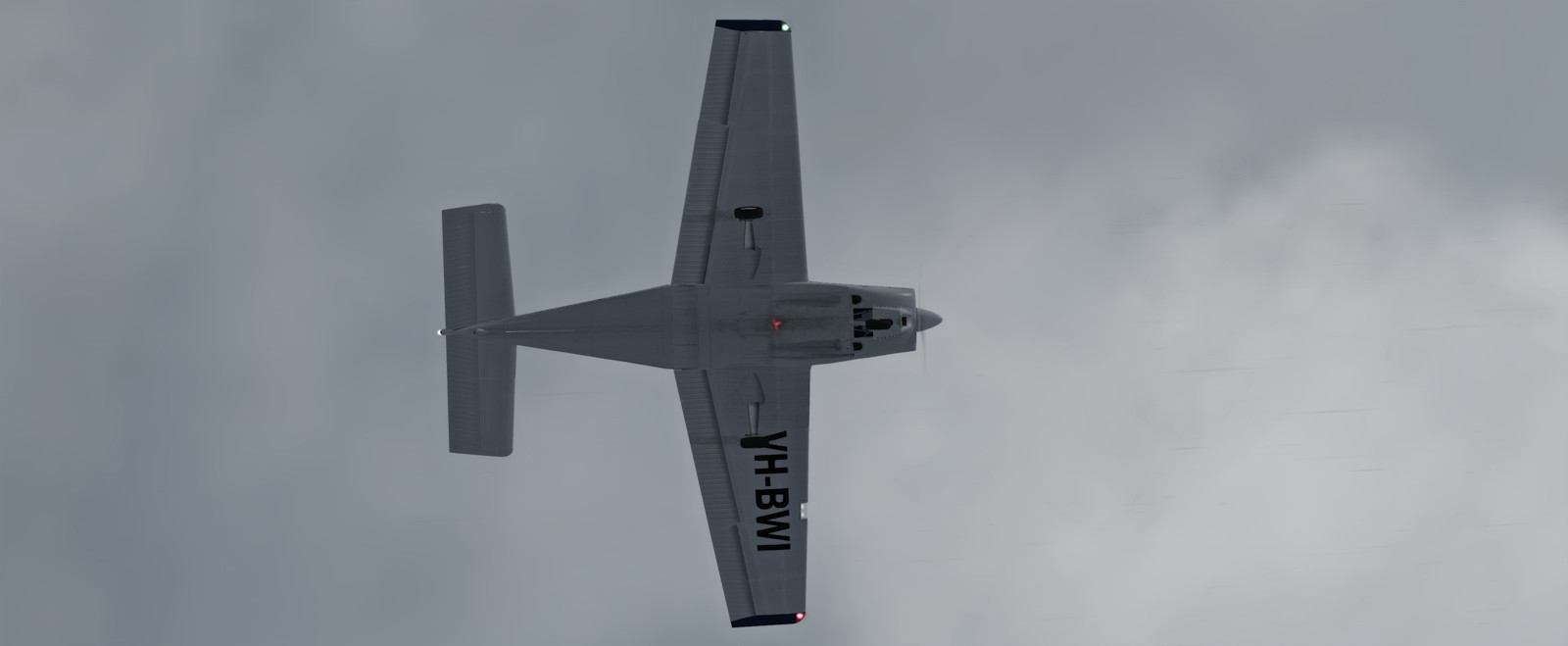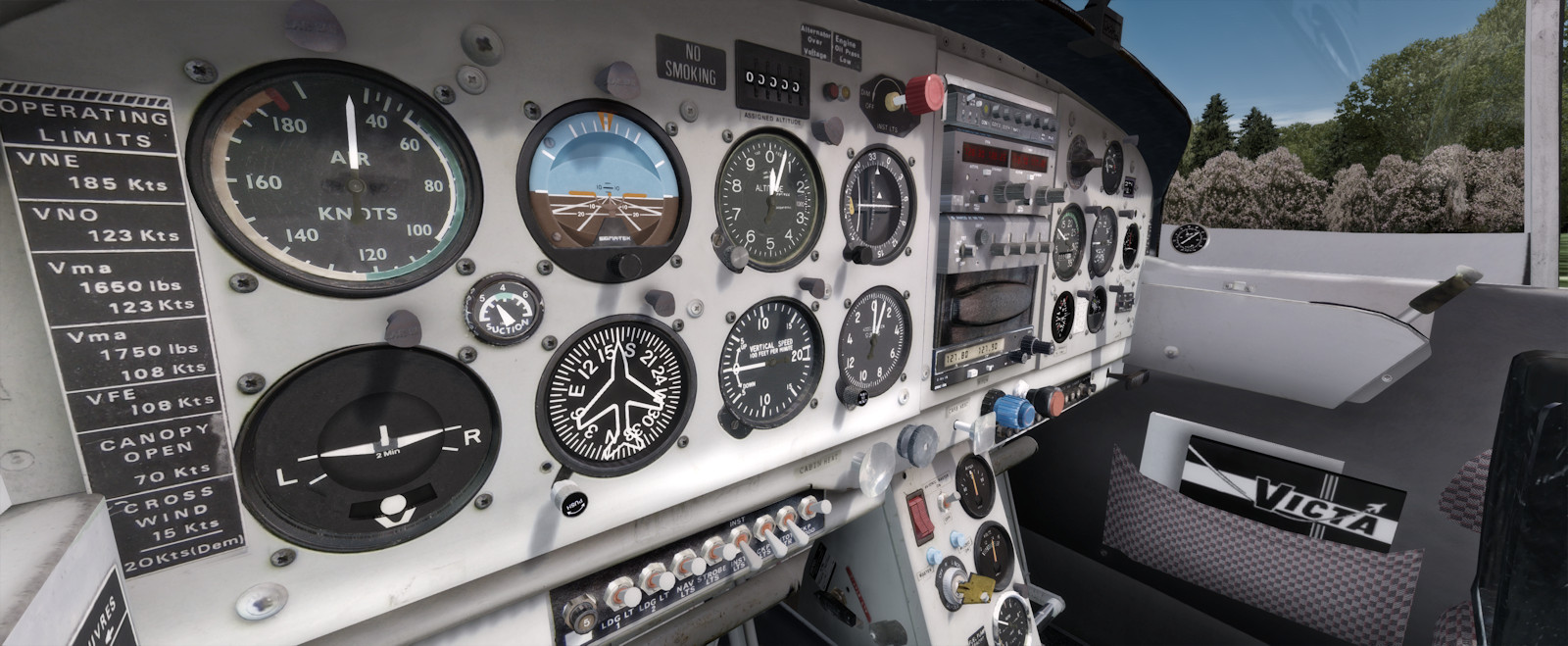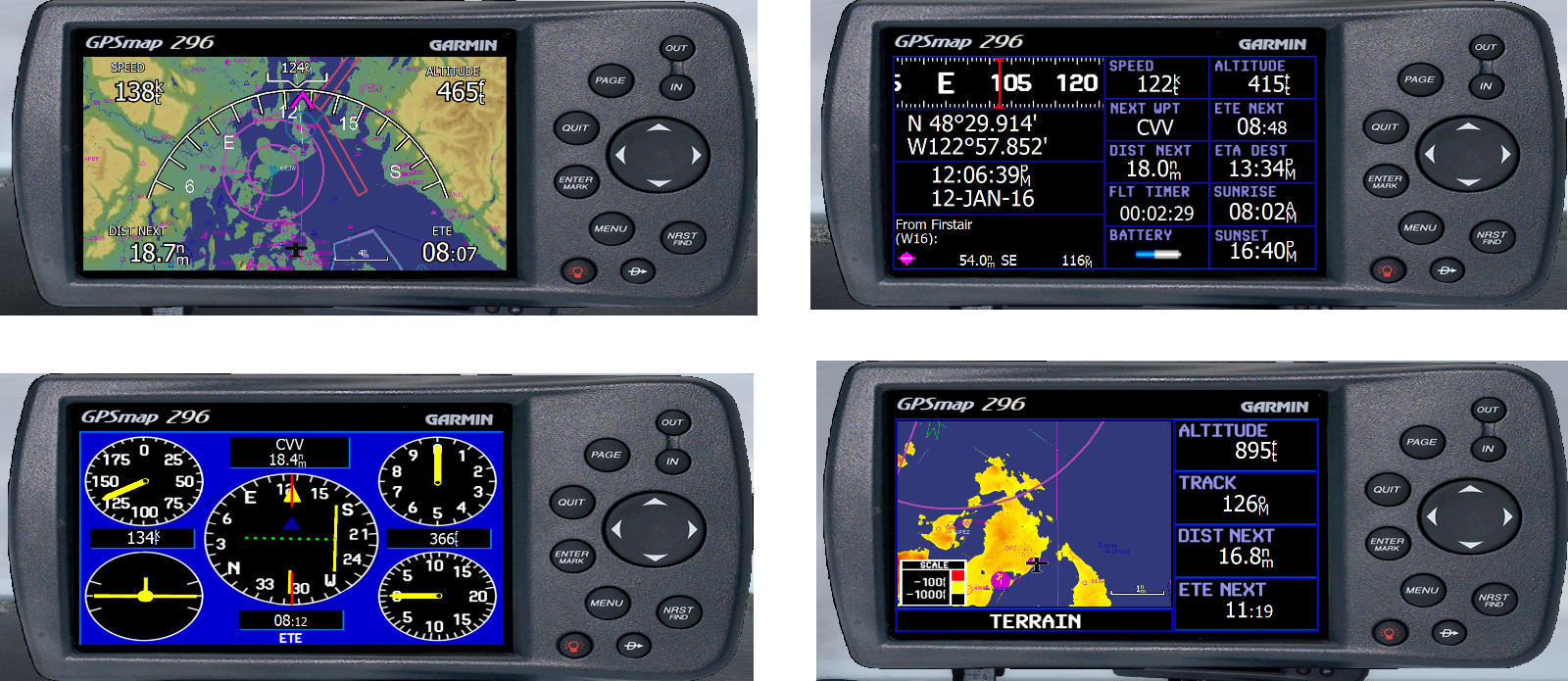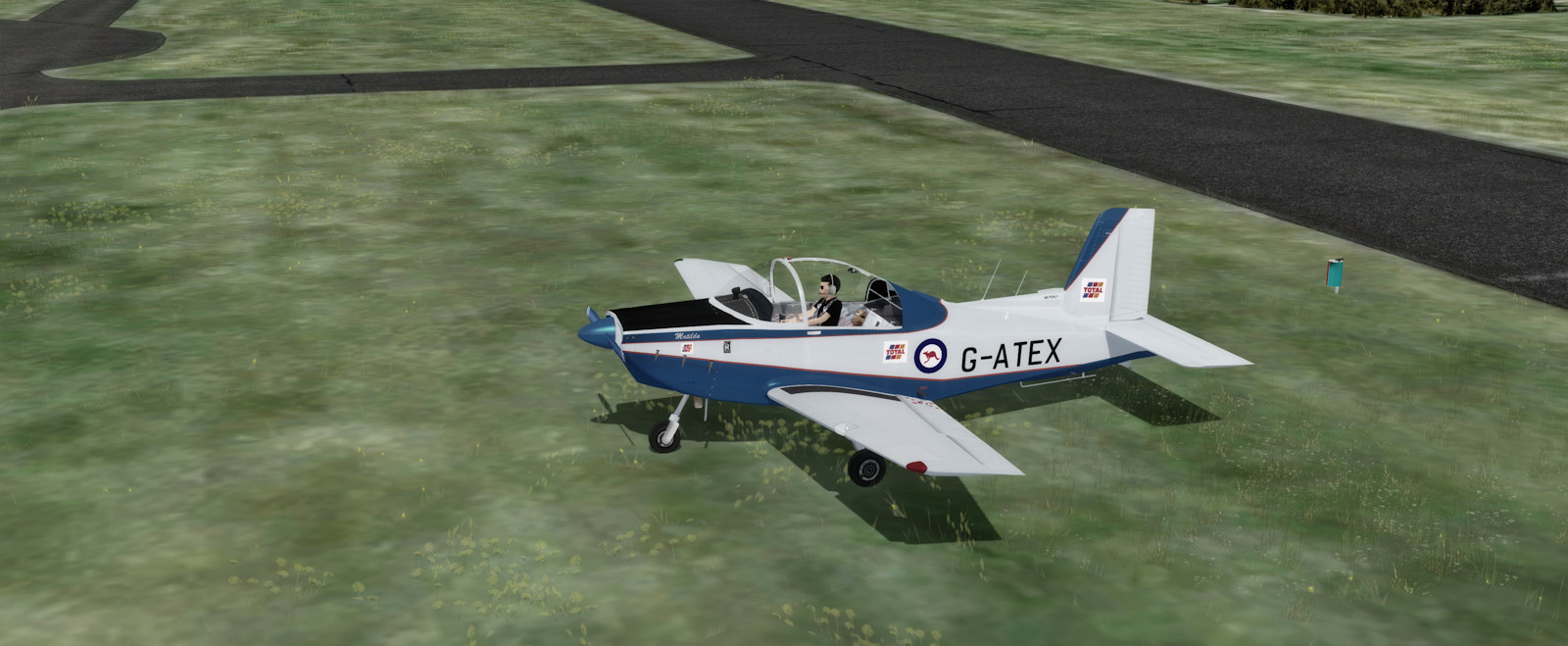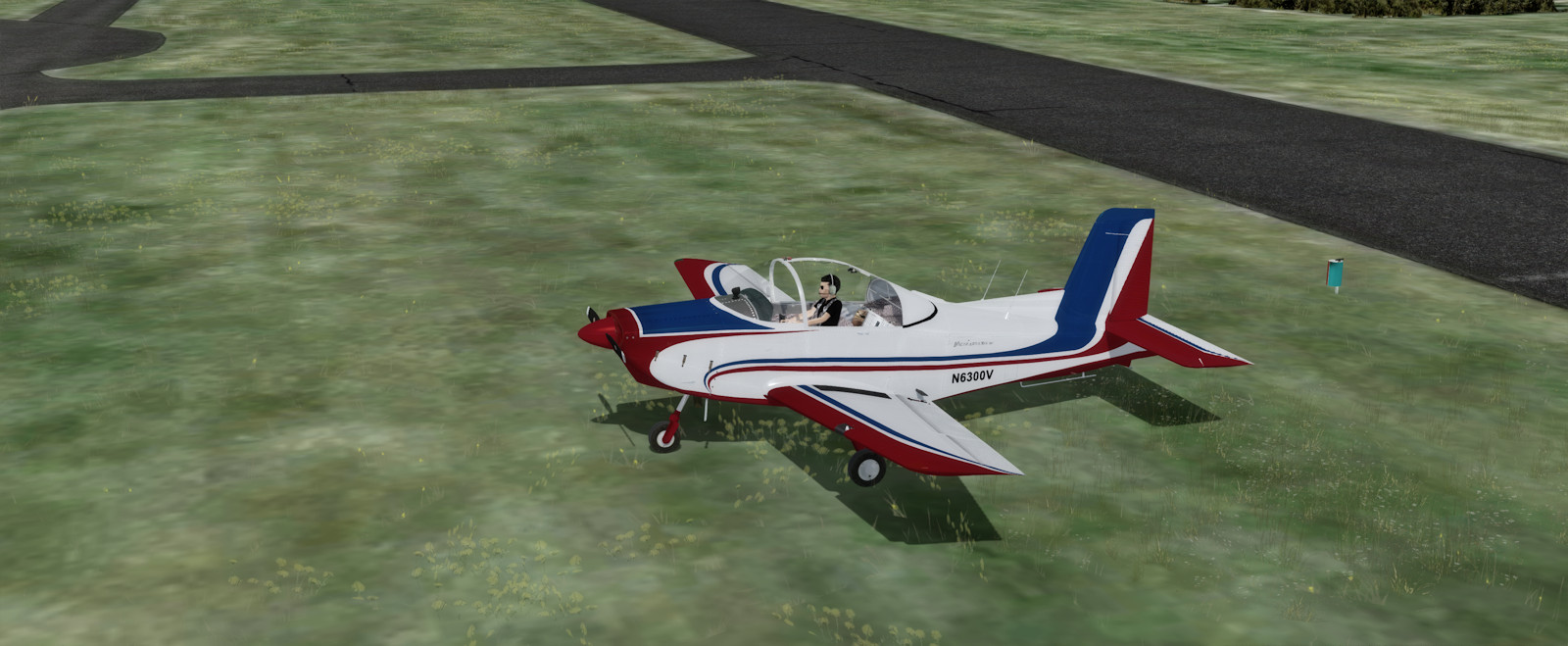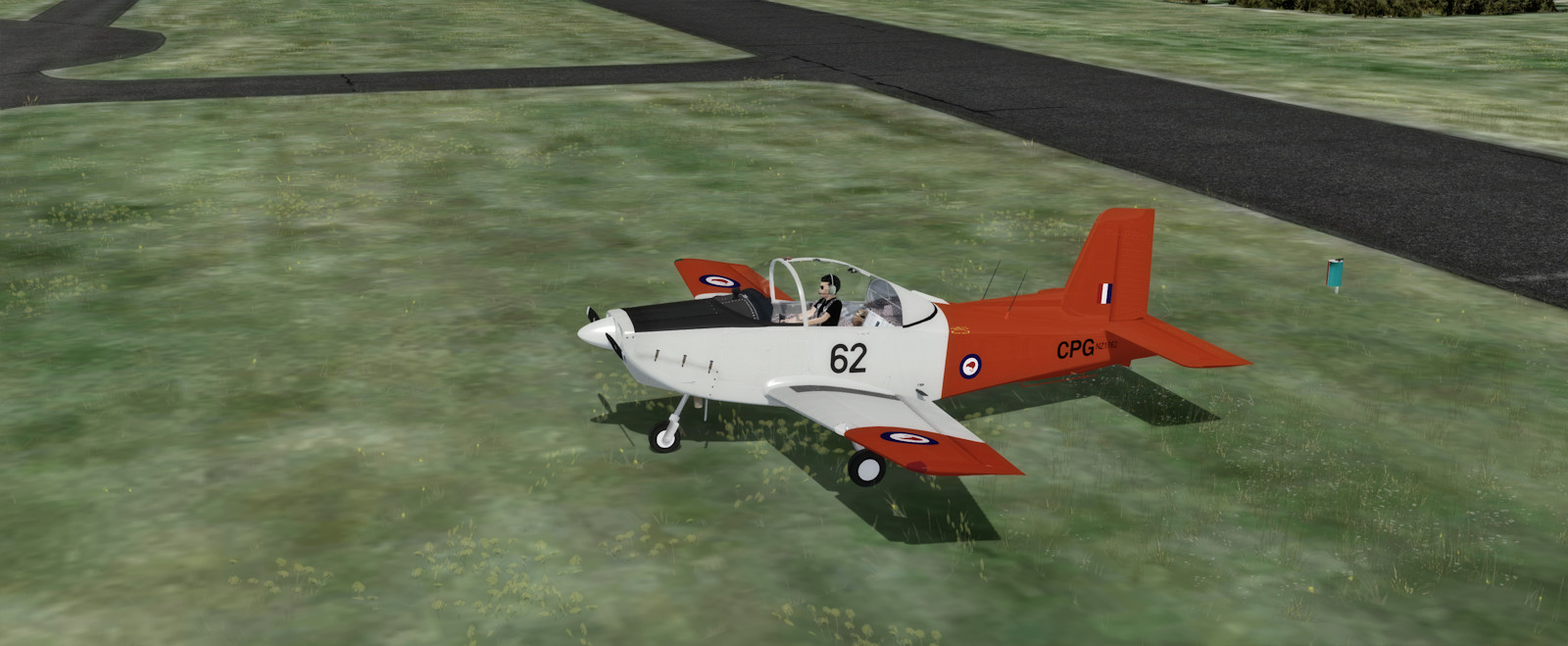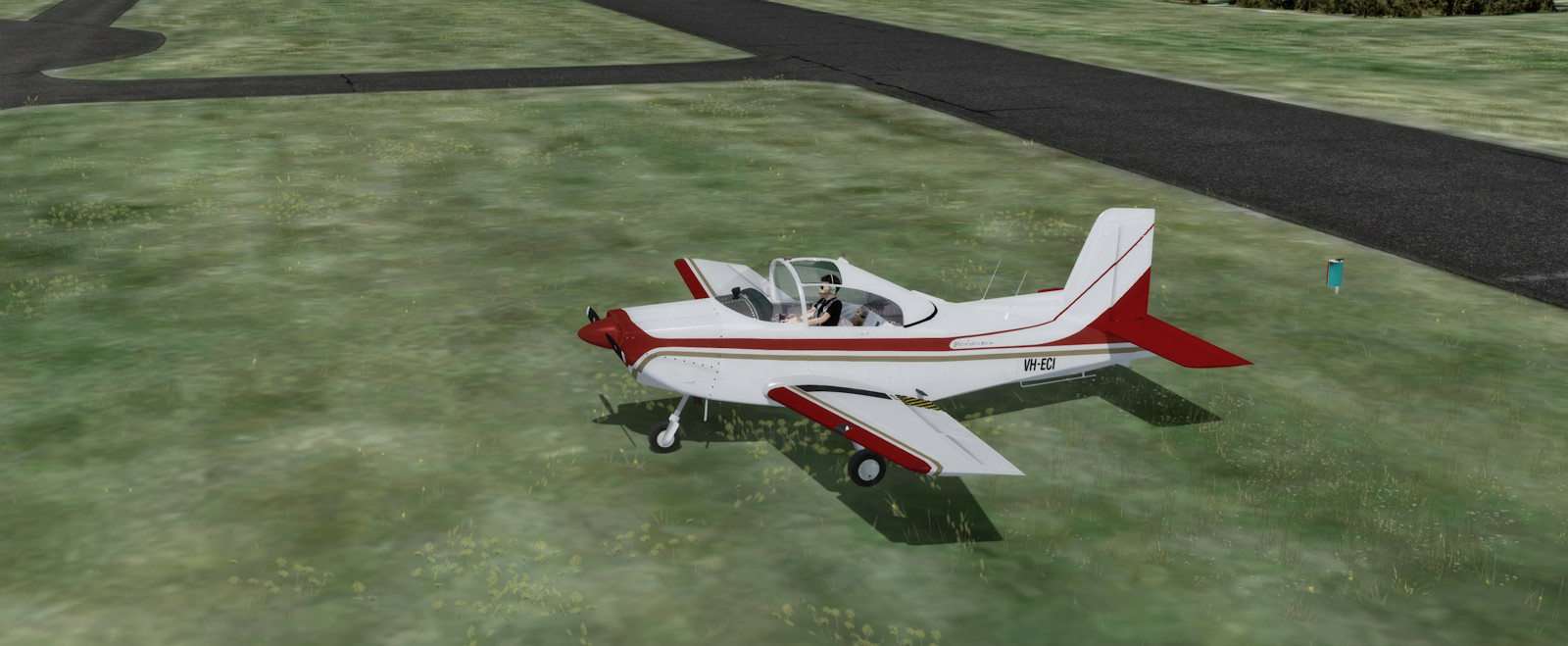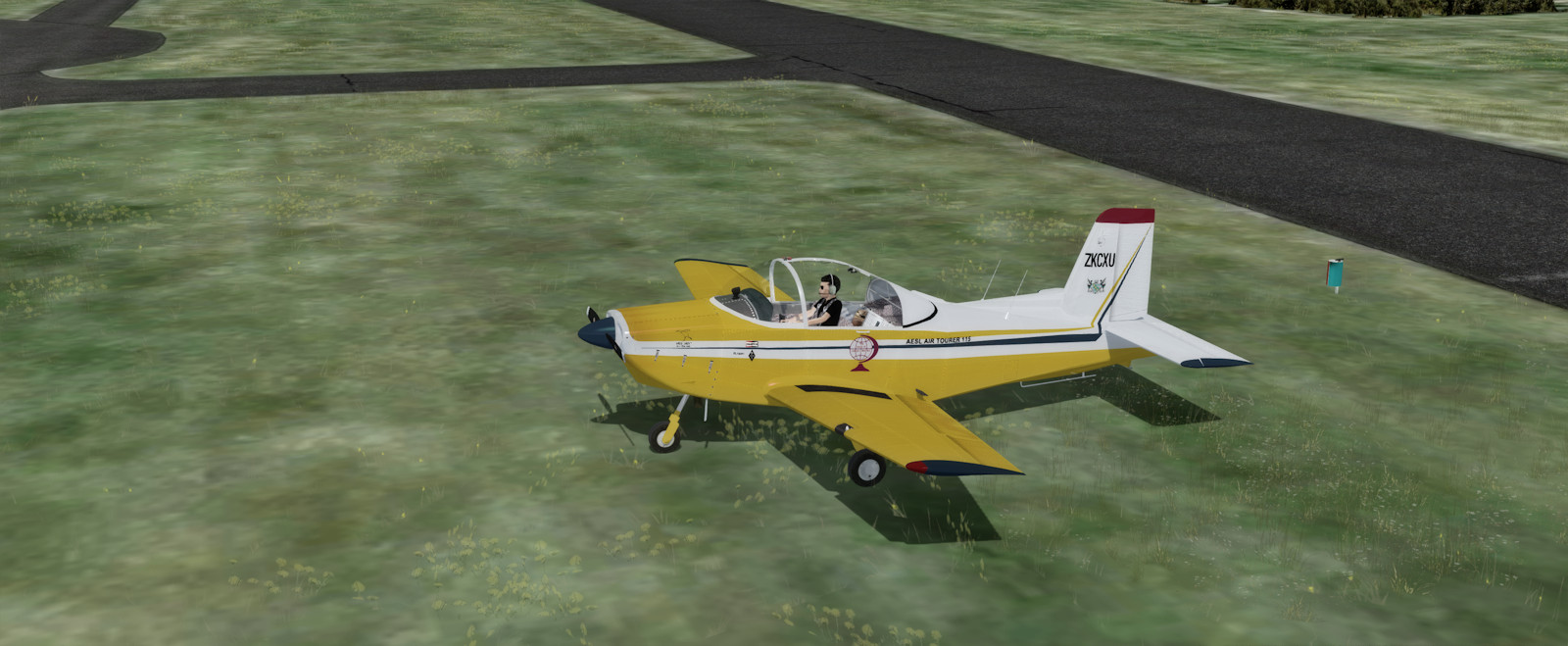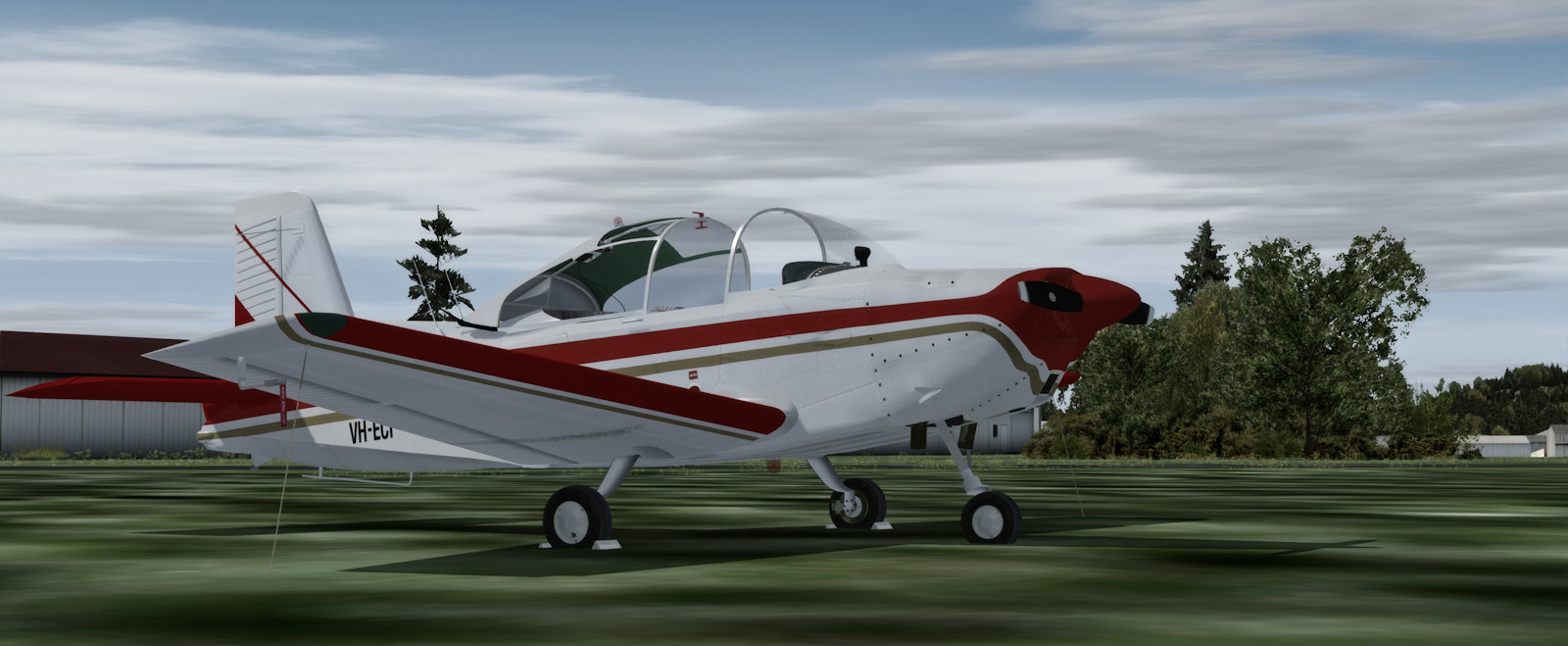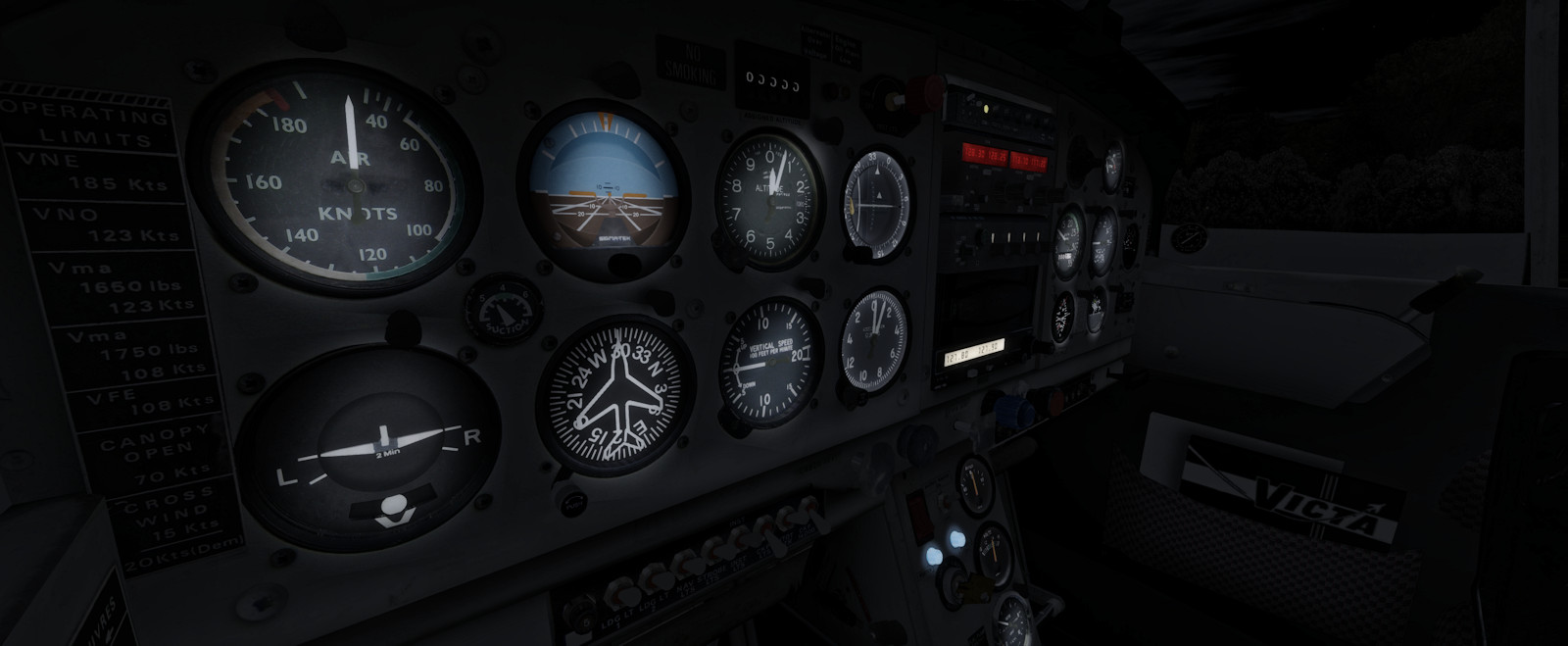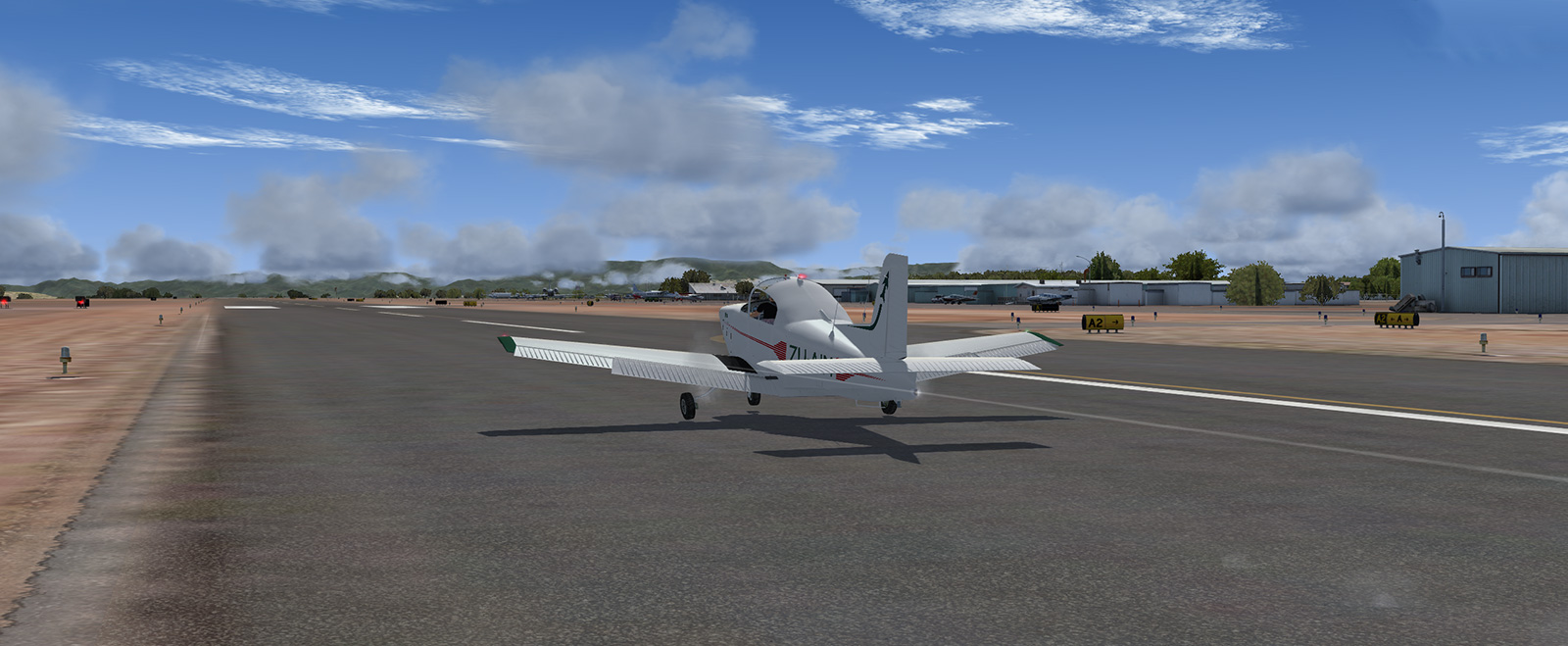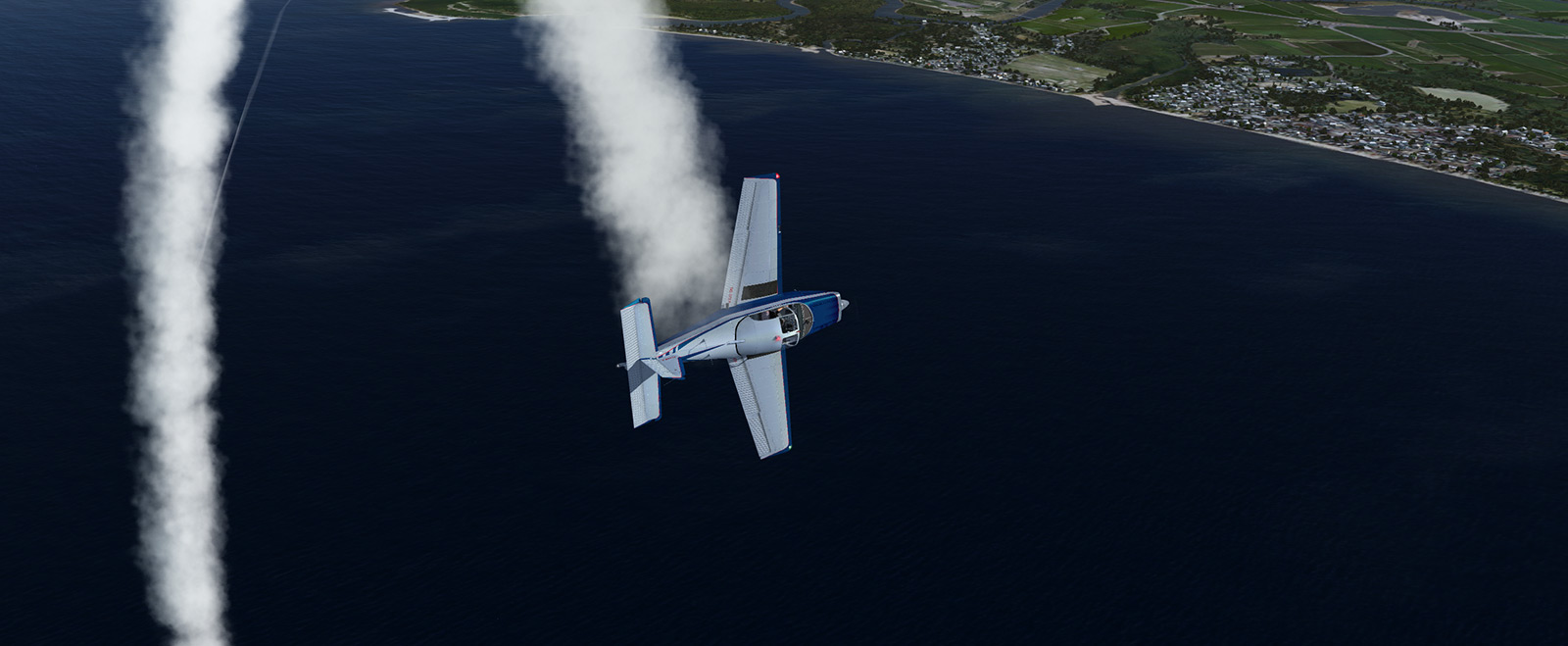Introduction
Orbx aren’t all that well known for their aircraft but one model, the Victa Airtourer 100 which was published around November 2014, is a hidden gem and has been one of my favourite cross-country sightseeing aircraft ever since.
The Orbx model is based on the real world 160hp Airtourer VH-ECI, and this aircraft was lovingly recreated by flight sim model developer Paul van Est. Now a year down the road, I thought it was about time to share this little beauty with you all.
History
The Airtourer was designed by Dr. Henry Millicer, of the Australian Government Aircraft Factory (GAF), and was the winning entrant in a (British) Royal Aero Club sponsored Light Aircraft Design competition.
The Airtourer Group then formed in Australia to build a 65 hp Continental powered wooden prototype, which first flew in March 1959. This attracted the interest of Victa (a lawnmower manufacturer) who undertook production of an all-metal version with a 100 hp Continental engine. This flew in December 1961. As the Airtourer 100, it entered production in June 1962. The more powerful Airtourer 115, with the 115 hp Lycoming engine, followed in September.
Victa built 170 Airtourers before succumbing to cheap American imports, and the design was purchased by Aero Engine Services Ltd. (AESL) of New Zealand, in 1967. They produced 94 Airtourers, including more powerful 130 and 150 hp versions, and the militarised version.
AESL's successor, New Zealand Aerospace Industries (NZAI) produced a trainer based on the Aircruiser development of the Airtourer, and sold it to the Royal Australian Air Force as the NZAI CT-4 Air trainer.
Availability and Installation
The Orbx Victa Airtourer is currently available direct from The FlightSim Store as a 'download only' product (a master back-up CD / DVD service is also offered for a minor additional cost). It is priced at AUD$39.95, or the equivalent on currency cross rates. The download file size of 690 MB seems large for what on the face of it seems to be a simple tourer, however, it has 11 texture folders each weighing in at a hefty 200 MB each when extracted. It requires 2.44 GB of HDD space for installation. A registration Key' is issued to be used during installation.
Model Features
The model features listed by Orbx for the Victa Airtourer are not that detailed but that’s not surprising for a fairly “simple” aircraft:High detail VC modelled in 3DS Max;
11 Detailed high definition liveries;
Custom electrical and lighting systems;
Simulated Garmin 296 GPS;
Programmable Com radio;
Full layered paint kit; and
Heaps of detail and features.
Visual Appearance
General. The words “stumpy” bubble, and goldfish bowl come to mind at first sight of this aircraft, as does “lawn mower” when you remember the history behind the Victa brand. It looks well-built and strong; given that it has aerobatic capability and I am going to be flying it, it needs to be! There’s no beauty prizes to be won here, but beauty is only skin deep, it’s what is under the covers that is more important and I am going to be looking from the inside out. The Airtourer is a fairly standard design low dihedral winged and fixed tricycle wheeled, general aviation aircraft. To gain entrance to the cockpit the whole canopy slides backwards so it makes for easy boarding especially as there are no spars to hit your head on. The Perspex canopy may be opened during flight up to speeds of 70 KIAS and on the ground during taxi.
The fuselage is constructed in two main sections, the forward section from the firewall to the rear of the cockpit and the aft section from the rear of the cockpit to the tail cone. These sections are joined to form a single unit and are constructed using traditional riveted aluminium alloy sheet.
Exterior. The external textures are made up from a full complement of Direct Draw Surface files including specular and bump maps. The rivets and grooves look very realistic as do all the bolt on pieces such as the foot step, canopy lever, aerials and rotating beacons on the roof and underside of the fuselage. There are some some subtle patches of wear and use like oil stains and mud splatter on the undeside of the wings.
If the pilot and GPS are selected to show in the control panel, then the pilot is fully animated from the external view including arms, legs and head when turning. The control column and rudders can also be seen. One feature I have not seen in any other aircraft is the GPS display can be seen to change in sync with the internal instrument.
A comparative review of photographs of real world aircraft to Orbx’s rendition reveal the exterior shape and dimensions to be very accurate and a true representation of the real world aircraft. Any noted variations were minor and are considered to be related to real world production variations or a degree of artistic licence on the part of the developer.
Interior. The cabin layout is very basic, the two side-by-side, straight backed, material covered seats are the only nod to comfort this aircraft possesses. There is a central armrest you can use when not in command as the shared control “Spade” column is also centrally located. Flaps can only be controlled on the pilot’s side and are of a typical car hand brake type design with 5 positions. Other controls such as rudder and wheel brakes are duplicated, one unusual feature is the wheel brakes are not on the toes of the rudders but are pull handles emanating from the panel, when used they operate on both wheels simultaneously. However, if you have rudder pedals you will find that you will still have differential braking (see later) although not accurate, it is very convenient. The park brake is situated on the central console along with the fuel gauge and fuel selector lever.
A comparative review of photographs of real world aircraft to Orbx’s rendition reveal the interior shape and dimensions to be very accurate and an excellent representation of the real world aircraft. However, the cockpit of VH-ECI is also used in the other variants included and although the interior layout would vary slightly there on only one design. This is noted by the developer and it is only the external livery that is different. Any other noted variations were minor and are, again, considered to be related to real world production variations or a degree of artistic licence on the part of the developer.
Various alternative cockpit camera views are provided to provide more detailed views of the instruments. The panel dashboard has a mid-grey metal finish and the panel background displays some scuffs and paint chips to give that lived in appearance.
Flight Instruments and Systems. All primary flight instruments are on the left side (pilot side) with only engine management instrumentation on the right side of the panel. The audio panel, communication and navigation receiver, transponder and Bendix/King KY97A radio are all located centrally.
The four primary flight instruments are laid out in the standard “T” arrangement with the turn coordinator and vertical speed indicator forming the common “six pack” layout. In addition to the six, the Victa Airtourer also has a VOR gauge and a G meter alongside. All the flight instruments are clear and easy to read as are the RPM and manifold pressure gauges on the co-pilots side. The rest of the panel, including switches and engine controls have an unobstructed view thanks to the centrally located yoke.
A superb addition to the package is a switchable, custom designed, Garmin GPSmap 296 GPS. This device has terrain avoidance and flight planning capabilities and can display the flight plan generated in the main sim as well as ones created “on the fly” on this device. It has many pages including Satellites Signals, Map, Terrain, Panel (Instruments), Active Route and Position Data pages. Other familiar features include direct to, nearest/find airport, create flight plan, waypoints, vectors and approaches. This makes cross country routes a breeze to fly.
Models and Liveries. Orbx provide the Victa Airtourer in a single model with eleven individual liveries (a selection only shown below), each having a unique aircraft registration number. Some of the liveries, such as ZK-DGY, belong to a military variant CT-4 and included as they are visually quite attractive. If you didn’t want so many textures, or to save disc cost, you could delete some of the texture folders and amend the aircraft.cfg file if you are confident in doing so. Also included is a fully layered paint kit for aircraft painting enthusiasts. Generally, the included liveries display a very high quality. Surface textures, reflections, and shadings give the aircraft a crisp and realistic appearance.
Animations, Lighting and Sounds
The animations of the primary and secondary control surfaces and other moving elements on Orbx’s Victa Airtourer are all modelled faithfully and include:
Primary control surfaces - ailerons, elevator, and rudder;
Secondary control surfaces - flaps;
Others - rolling wheels, various cockpit and cabin doors open / close; and
Various static elements.
External Lighting. The lighting effects on the Victa Airtourer are good, the standard red, green and white navigation lights are well drawn as are the landing lights which casts a nice crisp white when illuminating the ground. The light switch panel shows 2 landing light switches which is correct although they sit side by side on the port wing, the use of the second light merely increases the intensity. I particularly liked the rotating beacon although the switch that operates it is labelled “Strobe”.
Cockpit Lighting. Internally, the Victa Airtourer lighting is excellent, the instrument lights have a rheostat so they can be dimmed through pre-set levels, and the panel light switch also has a nice effect which you can see below. Finally, there is a pink cockpit flood light which lights everything with a red hue. Any Prepar3d v3.0 users will not be able to see these lighting effects due to a bug in the sim but this has been corrected in the latest v3.1 update. The lights in FSX work fine.
Sounds. The audio effects are effective and are reasonably representative of the aircraft. Unfortunately they only to appear to be recorded in mono so they sound a little flat. However the starter, engine start up and shut down sounds help to mitigate the lack of clarity.
General Characteristics and Performance Specifications
The general characteristics and performance specifications for the Victa Airtourer are provided in the table. This is based on data from the official Victa Air Tourer T6 Pilots Operating Handbook, data provided by Orbx, and general research sources. Some of this data varies between sources and also may be an approximation due to variances in data and the specific aircraft modelled by Orbx.
General Characteristics
| Crew | One |
| Passenger Capacity | One |
| Length | 6.7 m (22 ft) |
| Wingspan | 7.92 m (26 ft) |
| Height | 2.14 m (7 ft) |
| Empty Weight | 590 kg (1,300 lb) |
| Fuel Capacity | 131.8 l (29 imp gal) |
| Maximum Take-Off Weight (MTOW) | 892 kg (1,900 lb) |
| Power Plant | Textron Lycoming O-320-D1A (160 BHP) |
Performance Specifications
| Maximum Speed | 135 KIAS (155 mph) |
| Cruise Speed | 120 KIAS (138 mph) |
| Stall Speed | 50 KIAS (57.5 mph) full flaps |
| Range | 1,153 nm (1,327 mi, 2,135 km) |
| Service Ceiling | 15,500 ft (4,724 m) |
| Rate of Climb | 1,260 ft/min (384 m/min) |
Flight Performance
A specific Test Flight was conducted to test the flight performance of Orbx's Victa Airtourer. The flight was conducted in clear weather with a full fuel load and the aircraft at maximum take-off weight (MTOW). A cruise altitude of 4,000 ft was adopted and the route distance was particularly chosen to provide a basis upon which to test the range characteristics of the Victa Airtourer. Like most aircraft of this type, adjustments must be made to fuel / pax loading to remain within the MTOW limitations.
The aircraft was relatively easy to taxi using the steering nose wheel via the rudder pedals, differential braking can be used although not true to this model in real life. With flaps set for take-off, the aircraft can be flown off the ground at 60 KIAS allowing the speed to rise to 70 KIAS before attempting to climb. At around 200 ft the flaps can be raised and the optimum climb speed of 80 KIAS can be obtained. The Victa Airtourer establishes on the climb to cruise and climbed effortlessly until the aircraft was established at the cruise altitude.
During cruise, a power setting of approximately 75% was established for long range cruise, with a manifold pressure setting of 28.0 in Hg and a tachometer setting of 2,400 rpm. This cruise setting produced an average speed of approximately 115 KTAS, a fuel flow rate of approximately 38.87 l/hour, and endurance reasonably consistent with the range characteristics of the aircraft. Noted variances in performance were extremely minor and had negligible impact on the operation of the aircraft. The Test Flight confirms the modelling of the aircraft for speed and range performance to be very accurate. Maintaining level flight with the trim control initially takes a lot of practice, on my joystick, using the buttons the trim would leap several degrees at a time. Fortunately I have the Saitek Trim Wheel which was perfect. However, anyone without the wheel will have to resort to using the mouse wheel in the VC.
Configured for landing, with full flaps, and trimmed for a descent rate of approximately 500 ft/min, the aircrafts approach speed was approximately 70 KIAS and it touched down at approximately 60 KIAS, with a normal flare and landing roll out comparable with the specifications for the aircraft.
In testing the accuracy of the instruments, based on the measured Test Flight, the speed indications on the airspeed indicator were consistent with the averages measured. Additionally, when establishing a set rate of climb on the vertical speed indicator, the respective gain in altitude on the altimeter was achieved within the measured minute, and a standard rate turn was achieved within the measured two minute period using the turn coordinator.
This aircraft is approved for aerobatics at a MTOW of 1,900 lb (861 kg). The POH lists a mouth-watering assortment of manoeveurs such as Spins (flaps UP only and limited to 1.5 turns), Inside loop, Slow roll, Aileron roll, Barrel roll, Stall turn, half inside loop and roll out, Chandelle & Lazy eight and Inverted Flight. I tried a few of these with relative success, however, the aircraft felt a little lazy on some of the recoveries. In order to illustrate some of these manoeuvres I added the default smoke system from the default Alabeo Extra 300.
The performance of Orbx's Victa Airtourer was very good in flight, displaying the expected general flight characteristics of this aircraft. The Airtourer is an extremely capable mid-speed tourer as well as being a fun aircraft to throw around. The aircraft handles very nicely and is a delight to fly. Overall, the aircraft model displays a reasonably accurate rendition of the flight characteristics and performance of the real world aircraft.
Documentation
There are two manuals / documents provided in Adobe Acrobat format (.pdf) for the Victa Airtourer:
User Guide - this 53 page document details the setting up, a flying guide, and vital information on operating of the Garmin 296 GPS; and
Pilot’s Operating Handbook - this 76 page document is a copy of the original and a basis for the performance modelling of this aircraft.
Value for Money
On a value for money assessment, the Victa Airtourer is considered reasonable. When comparing the price to more well-known GA brands (Excluding A2A), the price is on a par, as is the flight model and visual quality, however the complexity isn’t but simplicity is a feature of this aircraft.
Simulator Performance
The aircraft model performed excellently within the existing settings I have in P3Dv3.1. I have most of my settings set very high with my frame rate pegged to 31 FPS and there was no need to make any adjustments. There was no discernible frame rate impact directly attributable to the Orbx Victa Airtourer and P3D continued to perform smoothly.
Technical Requirements
This version of Orbx’s Victa Airtourer is for FSX / P3D only. Other specified technical requirements are as follows:
Windows Vista, Windows 7, or Windows 8 (32 or 64bit);
Microsoft Flight Simulator FSX with SP1 and SP2 installed (or Acceleration Pack) or Lockheed Martin Prepar3d Flight Simulator (v1, v2);
Pentium V, 2 GHz or similar;
2 GB RAM;
1 GB graphics card; and
2.44 GB available HDD space.
Review Computer Specifications
The specifications of the computer on which the review was conducted are as follows:Intel Core i74770K @4.2 GHz ;
NVidia GTX980 Ti, 6 GB;
16 GB, Corsair DDR3, 1,866 MHz;
Windows 10 Pro, (64bit); and
Lockheed Martin Prepar3D V3.1.
Additional major add-ons include: Active Sky Next, REX Texture Direct & Soft Clouds; Orbx FTX Global BASE; Orbx FTX Global VECTOR; Orbx FTX Global openLC EU; Orbx FTX Global openLC Alaska/Canada; Orbx FTX Trees HD; Orbx FTX region series; and Orbx FTX airport series..
Conclusion
The Victa Airtourer is a testament to Paul van Est’s excellent skills as a flight sim aircraft developer. This is the ideal aircraft for sightseeing around Orbx’s magnificent sceneries as well as honing your cross country and aerobatic skills. Accurate modelling, high quality graphics and a reasonable price make Orbx’s Victa Airtourer a must have addition to your hangar.
Verdict and Scores
Verdict
| The Victa Airtourer continues to demonstrate Orbx’s exceptionally high standards and stands up well against other more well-known products. If this debut aircraft is indicative of what is to come from Paul van Est, then the future is looking bright. |
Scores
For |
Against |
Category |
Score |
|---|---|---|---|
| Superb Flight Model | Over sensitive trim | Internal Model | 9.0 |
| High Quality Textures | . | External Model | 9.0 |
| Excellent Garmin 296 rendition | . | Flight Characteristics (does it fly by the numbers) | 9.5 |
| Good Documentation | . | Flight Dynamics (does it feel like what it looks like) | 9.0 |
| . | . | Sounds | 8.5 |
| . | . | Documentation | 9.0 |
| . | . | Value for Money | 8.5 |
Overall Score

The Orbx Victa Airtourer is awarded an overall Mutley's Hangar score of 8.9/10, with a "Highly Recommended" |






